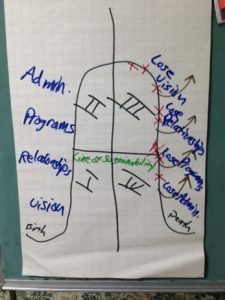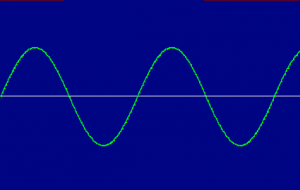Thanks to Indiana Regional Minister Rick Spleth for this perspective on Hope Partnership’s New Beginnings Assessment Service, which has helped hundreds of congregations make courageous decisions about their future direction.
In the Spirit . . .
I have been working with several of our congregations recently as they have been engaged in conversations about their future. We are doing this in partnership with Hope Partnership for Missional Transformation, one of our general ministries with connection to Disciples Church Extension Fund. The process we have been using is New Beginnings and its purpose is to engage the whole congregation in conversation about what God is calling their church to do and be in this moment in their life. A number of our congregations have benefited from this process, which has equipped them to make bold decisions together.
At the beginning of the consultation Hope Partnership invites me or another member of our Regional staff to engage the members of the church in “appreciative inquiry,” an evening when we tell again those moments in the life of the congregation when God felt most present and people felt most engaged. We inventory the gifts and talents that are in the church right now which we might use to engage in a new direction. Those evenings are typically filled with a lot of energy and imagination.
 A consultant from Hope Partnership closes the evening with a presentation about the typical life cycle of a congregation through stages of beginning, growth, stability, decline, and death. Visually the path takes the form of a bell curve with ascending and descending sides. Religious historians believe that all congregations move through this path, though the time they take varies greatly. It might be 10 years, or 100 years, or hundreds of years. In the Indiana Region we have congregations that are one year old and others that are 180. Vision and relationships give energy and direction to the beginnings of a congregation. Program and administration provide stability in the middle years of the cycle. As decline begins to happen the thing that is first diminished is vision. The thing that persists to the end is administration. Congregations at this point in their life cycle will often have governance structures that they are struggling to maintain or which constitute their primary activity together, rather than being the support system for wider mission activities.
A consultant from Hope Partnership closes the evening with a presentation about the typical life cycle of a congregation through stages of beginning, growth, stability, decline, and death. Visually the path takes the form of a bell curve with ascending and descending sides. Religious historians believe that all congregations move through this path, though the time they take varies greatly. It might be 10 years, or 100 years, or hundreds of years. In the Indiana Region we have congregations that are one year old and others that are 180. Vision and relationships give energy and direction to the beginnings of a congregation. Program and administration provide stability in the middle years of the cycle. As decline begins to happen the thing that is first diminished is vision. The thing that persists to the end is administration. Congregations at this point in their life cycle will often have governance structures that they are struggling to maintain or which constitute their primary activity together, rather than being the support system for wider mission activities.
It is a sobering exercise to be sure. Most of our congregations can identify with some evidence of decline—programs that are not as robust as they once were and at times some malaise about purpose and direction.
 This pattern of congregational life is predictable but it is not determinative. Hope exists when optimism seems unwarranted! At one of these conversations recently a wise Elder exclaimed that the image in front of them is not a bell curve but rather a sine wave. He is exactly right. A bell curve is simply one part of a longer “sine wave.” Sine waves occur throughout nature and life. They reflect the ebb and flow and rise and fall of lots of differing things, from the way sound moves through the air to the way civilizations march through time.
This pattern of congregational life is predictable but it is not determinative. Hope exists when optimism seems unwarranted! At one of these conversations recently a wise Elder exclaimed that the image in front of them is not a bell curve but rather a sine wave. He is exactly right. A bell curve is simply one part of a longer “sine wave.” Sine waves occur throughout nature and life. They reflect the ebb and flow and rise and fall of lots of differing things, from the way sound moves through the air to the way civilizations march through time.
A sine wave can also describe your church, but not automatically. Without intentional engagement and investment the bell curve image will, over some period of time, trace the history of any one congregation. The alternative, though, is to begin a new bell curve, which can happen at any point along the way. It happens the same way it did at the beginning of your congregation’s life—gathering people into relationship who are united by a common and compelling vision of what God has called them to do and be. That is exciting when it does happen, but it is often difficult to bring it about. It requires some recognition and acceptance of the fact that things are not as they once were and will not be again. Embracing that sober analysis gives the possibility for the current moment to be claimed as the downside of a sine wave. Denying that analysis most likely re-imagines the picture as a slide.
Have you ever ridden a roller coaster? It is a kind of sine wave too. What allows your coaster to make it up the second hill? It is the energy and momentum captured in the decline from the first hill. The vista on that second hill is almost always different from the first. The track has turned. And so, too, must our congregations turn as well, and ride the wave of a new future to which we are beckoned by God.
No one rides a roller coaster by themselves so do not attempt this alone! Invite the members and leaders of your congregation into this ride with you. And I would be happy to jump on board with you as well.
Blessings on you and your congregation,
Richard L. Spleth
Regional Minister



